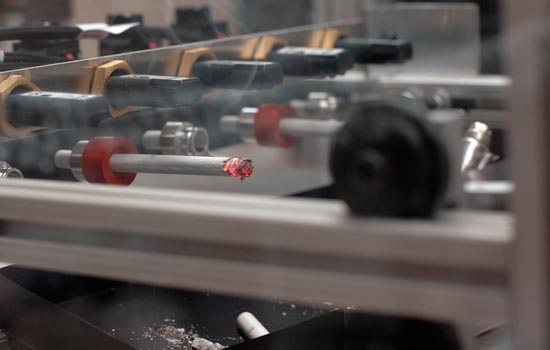Professor takes methodical approach in smoking study
‘Smoking machine’ measures particle inhalation and effects on human body
A. Sue Weisler | photographer
RIT students constructed a smoking simulation device which models how cigarette smoke impacts individual organs in the body.
Research at RIT is seeking to enhance knowledge surrounding the impact of smoking on human health. Risa Robinson, associate professor of mechanical engineering, is utilizing computational modeling, medical imaging and mechanical simulation to illustrate how individual particles inhaled with cigarette smoke affect the body and how they travel from the lungs to other organs.
The effort includes the construction of a smoking machine, built and designed by RIT students, which will be used to simulate how these particles build up over time and the impact the process can have on damaging the body’s particle-clearance mechanisms. They are particularly interested in the impact smoking has on teenagers, whose lungs are affected to a greater extent due to having smaller airways. The research is funded through a grant from the American Cancer Society and is being conducted in cooperation with RIT’s Departments of Medical and Biological Sciences and Medical Illustration.
“Previous research on the impact of particle deposits has focused on inundating laboratory samples with toxins and studying the response, the so-called ‘avalanche’ approach,” notes Robinson. “The work at RIT uses a ‘snowflake’ method whereby particles are allowed to build up over time, as they would in the body.”
Robinson believes her research can provide better evidence of the real-time effects of smoking and more properly link how particle buildup impacts numerous systems in the body. She also hopes to shed light on how these particles can impact passive smokers, through secondhand smoke, and use her data in additional types of particle analysis, including studying the impacts of nanoparticles and allergens.
“Through the use of new computational and imaging technologies we can learn more than ever before about how particle inhalation and buildup affect human health,” Robinson adds. “This information will increase our knowledge of the negative effects of smoking and air pollution, while also providing needed information to enhance treatment, including better application of inhaled medications.”
Robinson’s collaborators include Kathleen Lamkin Kennard, assistant professor of mechanical engineering, and Richard Doolittle, professor and head of the Department of Allied Health Sciences, both at RIT; Todd Pagano, assistant professor of science and mathematics and Director of the Laboratory Science Technology program in RIT’s National Technical Institute for the Deaf, and undergraduate and graduate student researchers.







